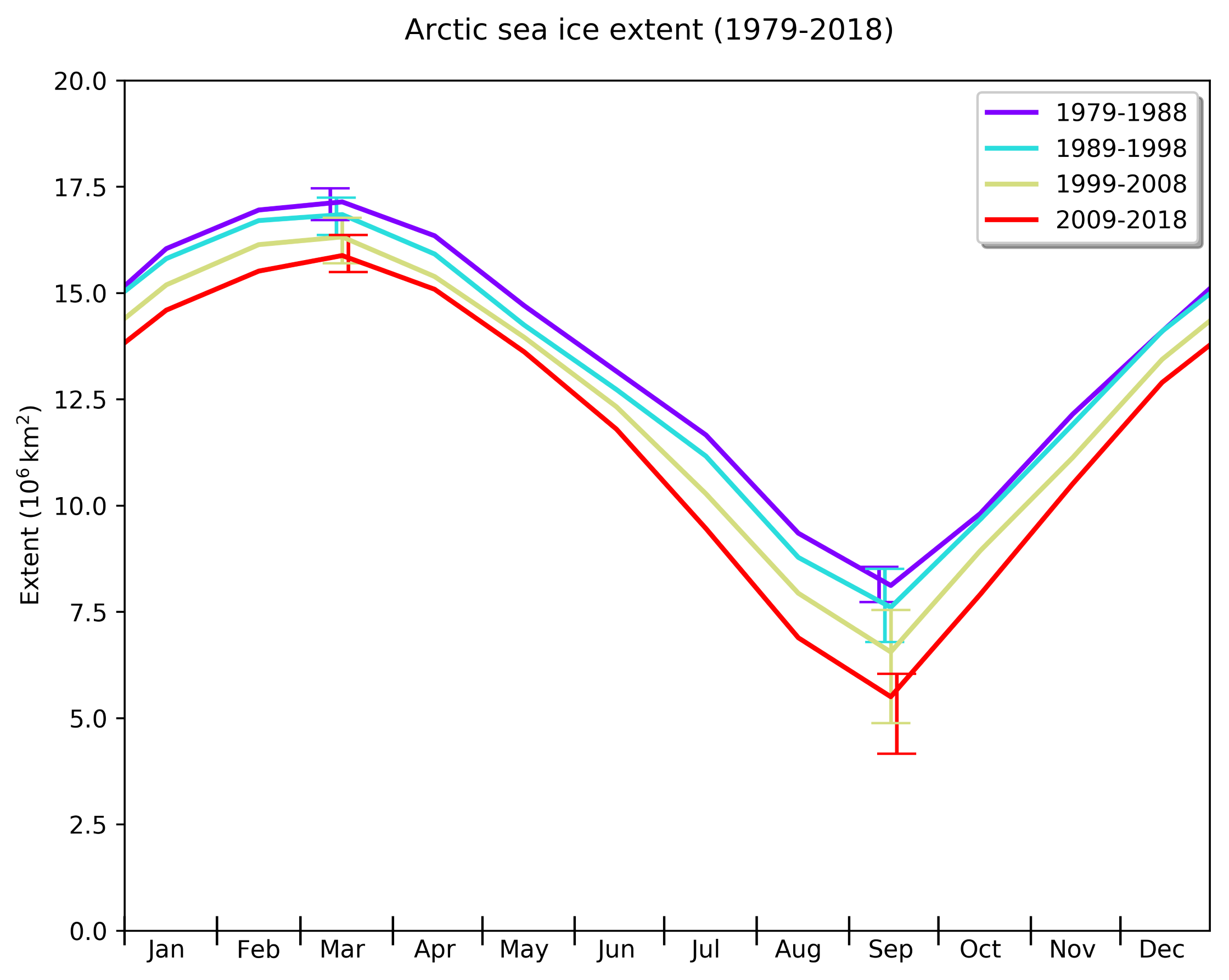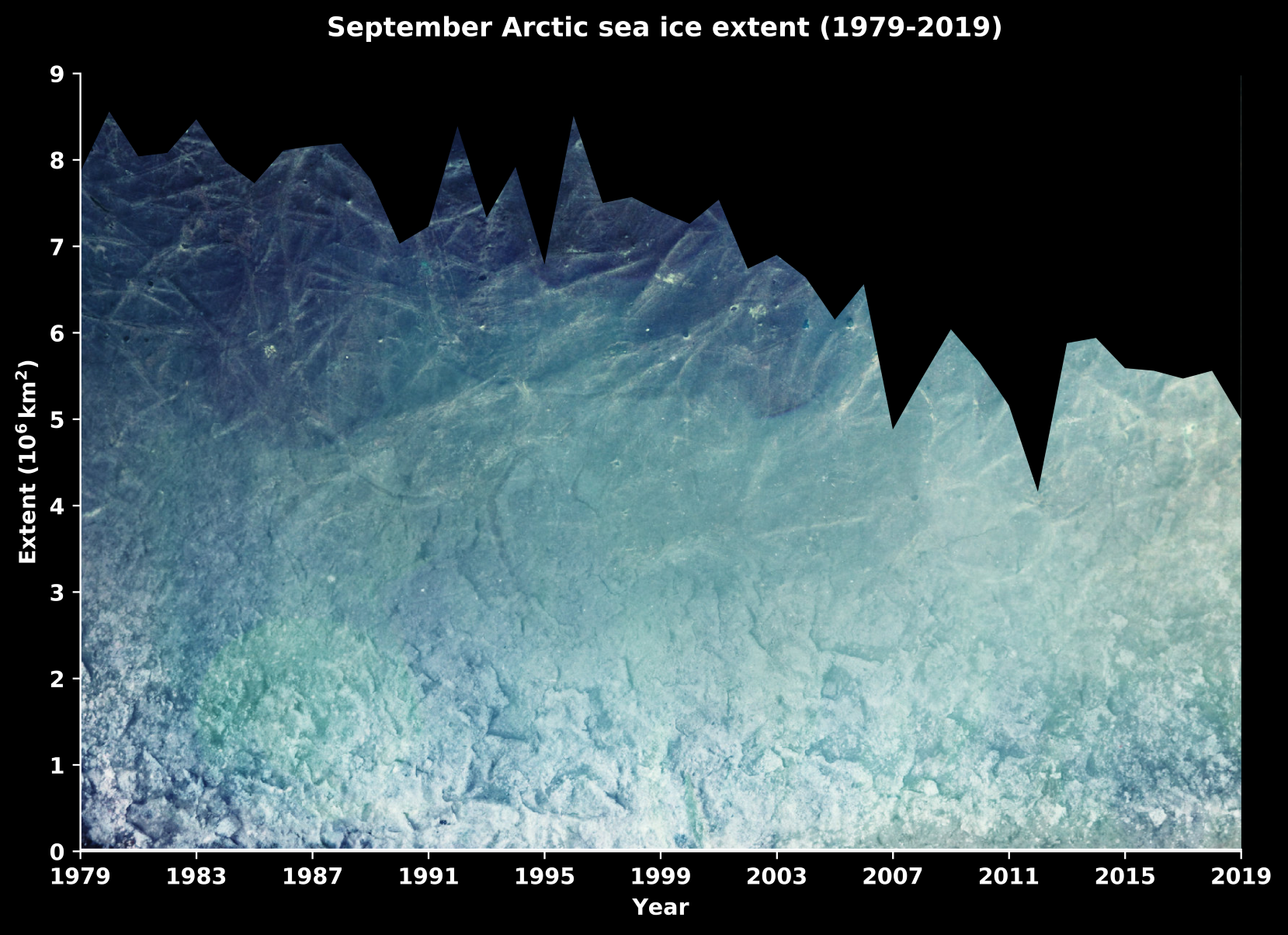Sea ice briefs
An archive of Arctic and Antarctic sea ice briefing documents
Monitoring sea ice at the poles
To keep government informed about the state of the sea ice, scientists from the Met Office Hadley Centre produce sea ice briefings each year which are released at roughly monthly intervals throughout the summer. This page provides some context around the key metrics used for monitoring sea ice, gives a summary of the most recent briefing, and provides links to all past briefings.
Sea ice is frozen seawater that floats on the surface of the ocean and is found when temperatures are cold enough for water to freeze. Sea ice is a key component of our climate system because it insulates the ocean in winter and reflects sunlight in summer, as well as providing a habitat for a range of species. However, Arctic sea ice has declined rapidly over the past few decades as global temperatures have risen, and this decline is expected to continue in future.
The amount of sea ice in the Arctic and Antarctic can be measured using sea ice ‘extent' - the total area of ocean for which at least 15% of the surface in the immediate vicinity is ice-covered. Sea ice extent is not constant throughout the year; sea ice grows and melts in response to the changing seasons.
Arctic sea ice normally reaches a maximum extent around March and a minimum extent in September, whereas Antarctic sea ice normally reaches its maximum extent in September and minimum in February.

Decadal-mean Arctic sea ice extent seasonal cycles using the HadISST.2.2.0.0 dataset (Tichner & Rayner, 2014). Error bars show the monthly values for the maximum (March) and minimum (September) extent
Sea ice is strongly affected by the atmosphere and the ocean, and even small changes in temperature can cause large changes to the yearly cycle of sea ice melt and growth. As global temperatures increase, ‘polar amplification’ is causing the Arctic to heat up much more quickly than the rest of the planet, and both maximum and minimum sea ice extent are decreasing year on year.
In the Arctic, the September minimum sea ice extent is used to compare the change in sea ice extent year on year. The Arctic will be considered 'practically ice-free' when the September extent falls below 1 million square km.

September minimum Arctic sea ice extent over the satellite record from 1979-2019
Briefing documents
2025
- Arctic and Antarctic sea ice brief - June 2025
- Arctic and Antarctic sea ice brief - July 2025
- Arctic and Antarctic sea ice brief - August 2025
- Arctic sea ice minimum and Antarctic sea ice maximum report - September 2025
- Arctic and Antarctic end-of-season report - October 2025
2024
- Arctic and Antarctic sea ice brief - June 2024
- Arctic and Antarctic sea ice brief - July 2024
- Arctic and Antarctic sea ice brief - August 2024
- Arctic sea ice minimum and Antarctic sea ice maximum report - September 2024
- Arctic and Antarctic end-of-season report - October 2024
2023
- Arctic and Antarctic sea ice brief - June 2023
- Arctic and Antarctic sea ice brief - July 2023
- Arctic and Antarctic sea ice brief - August 2023
- Arctic sea ice minimum and Antarctic sea ice maximum report - September 2023
- Arctic and Antarctic end-of-season report - October 2023
2022
- Arctic and Antarctic sea ice brief - June 2022
- Arctic and Antarctic sea ice brief - July 2022
- Arctic and Antarctic sea ice brief - August 2022
- Arctic sea ice minimum report - September 2022
- Arctic and Antarctic end-of-season report - October 2022
2021
- Arctic and Antarctic sea ice brief - June 2021
- Arctic and Antarctic sea ice brief - July 2021
- Arctic and Antarctic sea ice brief - August 2021
- Arctic sea ice minimum report - September 2021
- Arctic and Antarctic end-of-season report - October 2021
2020
- Arctic and Antarctic sea ice brief - June 2020
- Arctic and Antarctic sea ice brief - July 2020
- Arctic and Antarctic sea ice brief - August 2020
- Arctic and Antarctic sea ice brief - September 2020
- Arctic and Antarctic end of season report - October 2020
2019
- Arctic and Antarctic sea ice brief - June 2019
- Arctic and Antarctic sea ice brief - July 2019
- Arctic and Antarctic sea ice brief - August 2019
- Arctic sea ice minimum report - September 2019
- Arctic and Antarctic end of season report - October 2019
2018
- Arctic sea ice melt season update - June 2018
- Arctic sea ice melt season update - July 2018
- Arctic sea ice melt season update - August 2018
- Arctic sea ice minimum report - September 2018
- Arctic sea ice melt season summary - October 2018
2017
- Winter sea ice review - March 2017 (PDF 3.4 MB)
- Arctic sea ice melt season update - June 2017 (PDF 1.2 MB)
- Arctic sea ice melt season update - July 2017 (PDF 0.7 MB)
- Arctic sea ice melt season update - August 2017 (pdf 1.4 MB)
- Arctic sea ice minimum report - September 2017 (pdf 1.4 MB)
- Arctic sea ice melt season and Antarctic sea ice state 2017 - October 2017 (pdf 2.6MB)
2016
- Arctic sea ice melt season update - June 2016 (PDF 333 KB)
- Arctic sea ice melt season update - July 2016 (PDF 544 KB)
- Arctic sea ice melt season update - August 2016 (PDF 196 KB)
- Arctic sea ice minimum report - September 2016 (PDF 467 KB)
- Arctic sea ice melt season summary - October 2016 (PDF 1.31 MB)
2015
- Arctic sea ice minimum report - September 2015




